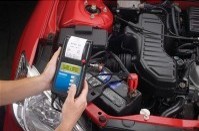 It is possible to prolong your battery’s useful life by implementing a regular car battery maintenance routine. As with any part of your vehicle, this should form part of the process to keep your car in a good roadworthy condition.
It is possible to prolong your battery’s useful life by implementing a regular car battery maintenance routine. As with any part of your vehicle, this should form part of the process to keep your car in a good roadworthy condition.
Here are a few tips to make that process “Nice and Easy” for you and bound to make your vehicle “Love You” for it:
Perform regular inspections and testing
With proper maintenance, it will be easier to detect potential problems in automotive batteries. Perform routine testing and review once or twice a month for optimum performance. It will prevent one of the most common forms of battery degradation, known as battery acid stratification.
Preventing battery tray from corroding
The tray holds the car battery in place and should be checked for any signs of corrosion and rust. Mild to moderate corrosion can be treated by wire brushing the surface with baking soda and water. Once the corroded areas are treated, make sure to rinse with water. (Please ensure to use your safety glasses.)
To prevent corrosion, a protective coating of anti-corrosion/rusting paint should be applied. This will prolong the life of the tray and prevent irreparable damage from forming.
Use A Proven, Yet Basic, Car Battery Maintenance Check-Up Routine As Follows:
- First, make sure that the top of the automotive battery is dry and clean. Accumulated dirt and grime could cause the car battery to discharge on the casing. Wipe off dirt with static-free cloth or rag.
- Next, inspect screws, clamps, cables and terminals for loose connections, damage, scratches, cuts and breakage. Check for corrosion as well, and be sure that the connections are tight and clean.
- Prevent overheating of connections and posts by applying grease formulated to withstand high temperatures. This will provide extra protection where it’s needed.
- Check the vehicle battery case for cracks, warping and other physical damages. If the casing is warped or cracked, it’s possible that an overcharging has occurred due to a faulty alternator or the battery short-circuited.
- Inspect water levels (maintainable types only) frequently to make sure that they cover the top of the battery plates. If needed, top up the plates using demineralised or distilled water. Don’t use tap water, unclean water or acid. (Please do not over-fill, which will cause water spillage).
- Routinely check car batteries with a voltmeter, battery analyser or hydrometer. Charge the battery if required.
Keynote:
Vehicle manufacturers have recommended car battery maintenance procedures for their products, which are found in your service manual. Moreover, you can follow the guidelines outlined by Century for their batteries to ensure their integrity and longevity.
So, when in doubt, refer to a licensed mechanic or a battery support technician from your service supplier.
We highly recommend a great resource on common frequently asked battery questions. (Opens in new window)
Next Page: Battery Recycling
